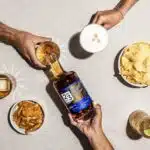SPIRITS
An Exciting – Game Changer For Australian Rum

WORDS: Ocean Road Magazine Interview with Paul Messenger PHOTOGRAPHY Supplied
An interview with Paul Messenger, Husk Rum Distillers
Q: Is this the new taste of Australian rum?
A: “We settled on our family farm in 2012 and established Husk Distillers the same year, but the seed of the idea was planted in 1998.
While flying over the Nullarbor Plain I read an article about a surveyor in Tasmania who lobbied to change the excise law enabling small distilleries to operate legally. That was the start of Tasmanian Whisky and, being fond of the occasional dram, I thought to myself, what a bloody good idea!
I never forgot that story and even travelled to Tasmania where I tracked down the whisky which was every bit as good as I imagined. But a young family and busy career kept the idea at bay until a family holiday to the Caribbean in 2009.
There we discovered the vibrant, exciting and colourful world of rum. On the small island of Martinique, I was introduced to agricole rum in a Ti Punch, and then later a 20-year-old tropical-aged sipping rum, equal to or better than the finest malt whisky I knew. That long-held idea now re-surfaced and would change our lives forever, but instead of whisky, my thoughts turned to the vast fields of sugar cane in the valleys of the Caldera Coast.
But what intrigued me most from my visit to Martinique was how the locals explained to me that, being made from fresh cane juice rather than industrial molasses, their rum has “terroir” – that difficult-to-define character, the taste and soul of the place where it’s made.
Cane juice rum had never been made in Australia before but in the years that followed, I began experimenting by fermenting and distilling fresh juice. As I learnt more about spirits and rum-making I began to better understand the notion of terroir. In simplest terms, it refers to produce from a particular region that reflects the provenance of that land and its people.
Some things can be made anywhere in the world without limitation but products with terroir can only be made in certain places and often only at certain times of the year.
Cane juice rum must be seasonally harvested and the taste of the rum is directly impacted by the character of the land where the cane is grown – the geology, soil, water, seasons and climate.
On a broader level terroir encompasses the physical, social and historical aspects of a place and its people. The infrastructure, commerce and lifestyles of work and play all contribute to what, where and how things are grown, made and consumed.
Ultimately terroir is part of the culture and identity of a people and place.
In developing this new style of Australian rum, our goal is to broaden the appeal of this most versatile spirit and introduce drinkers to new flavours and ways of enjoying rum.
We also want to promote sustainable, farm-to-bottle distilling and connect deeply with our community. Having travelled through the Scottish Highlands and the Caribbean islands, experiencing first-hand the depth of cultural connection between people and centuries-old distilleries I developed an understanding of the role that spirits and provenance can have in developing the culture and identity of people.
Rum is very much a part of the culture and identity of the people of Martinique, and in time this new style of juice rum that reflects our provenance may well become a part of ours. That to me is the ultimate destination.”











